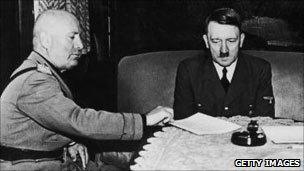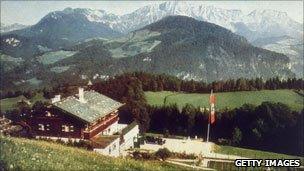Osama Bin Laden: The power of shrines
- Published
- comments

Bin Laden's body is somewhere in the Arabian Sea
Osama Bin Laden's body was buried at sea to deny his followers a shrine, it has been widely reported. But why do the graves of leaders matter so much?
For a man who had been the world's most wanted, it was a deeply undistinguished final resting place.
The remains of Osama Bin Laden met an inauspicious fate - his body dropped into the ocean from an American aircraft carrier.
US officials were at pains to insist that the process was conducted in "strict conformance with Islamic precepts and practices".
But the purpose of his burial at sea was clear - to ensure that there was no grave to become a shrine for supporters, and a recruiting tool for extremist Islamism.
It's a motive with clear historical antecedents. Victorious regimes, particularly when confronted with ideological movements with charismatic leaders, have often been anxious to deny their defeated enemies a rallying point, a place where sympathisers can gather to venerate their dead.
The partially-cremated corpse of Adolf Hitler was dug up by invading Soviet forces from its initial burial site in Berlin before being moved several times - its ultimate fate being shrouded in mystery, with some accounts claiming his skull and jawbone were taken to Moscow.
The Berghof, the dictator's home in the Bavarian alps, was demolished in the early 1950s by the West German government, who feared it would become a focal point for neo-Nazis. Other Nazi leaders executed at the Nuremberg trials by the Allies were cremated and their ashes were scattered in the Conwentzbach river to frustrate any attempt to by latter-day sympathisers to commemorate them.
At the other end of the political spectrum, the body of revolutionary Ernesto "Che" Guevara was photographed perfunctorily by the enemies who killed him in Bolivia before his burial in an unmarked grave - his opponents perhaps anticipating the cult he would inspire.
The fate of Bin Laden echoes the British empire's approach to an earlier Muslim insurgent - Muhammad Ahmad, known as the Mahdi, whose tomb in Sudan was destroyed to prevent it becoming a rallying point for supporters.
The Mahdi enjoyed military successes against the British - including the slaughter of the garrison in Khartoum - before dying of typhus. His followers were crushed by the British, his tomb destroyed and his bones thrown in the river.

Mussolini and Hitler's remains were both subject to much posthumous movement
The conscious effort to avoid shrines to enemies mirrors the efforts of ideological regimes to consciously create shrines.
The embalmed corpse of Vladimir Lenin, publicly displayed in a Red Square mausoleum long after his passing, may have been intended to represent the persistence of the USSR's founding mythology.
But this meant that, by extension, the fate of Joseph Stalin's remains - initially displayed alongside the Georgian-born dictator's predecessor, but later removed during Krushchev's thaw - symbolises the process by which his reputation diminished.
For Prof Michael Cox, of the department of international relations at the London School of Economics, the watery fate of Bin Laden goes beyond the particulars of the post-9/11 world.
The mythology of many revolutionary ideologies depends so heavily on the veneration of fallen heroes, he says, that their opponents will always attempt to arrest any such emotional appeals.
"It's not specifically an Islamic issue.
"There's a broader point about the role of martyrs in any kind of struggle - not just in terms of the iconography, but also how martyrdom is used as a means to continue that struggle. Martyrs help create new followers."
Indeed, nothing reveals the power of shrines more than the battles which are fought over them after their inhabitants have died.

Hitler's mountain chalet was destroyed to prevent it becoming a shrine
Italian leader Benito Mussolini's corpse was, variously, hung from meat hooks by victorious partisans, buried in an unmarked grave, dug up by loyal fascists, re-captured by the authorities and finally re-interred in a crypt in the years following his death.
Likewise, the Valley of the Fallen near the Spanish capital Madrid, which houses the tomb of dictator Francisco Franco and was partly built by Republican prisoners, divides many Spaniards along civil war lines to this day.
For this reason, believes historian Laurence Rees, author of The Nazis: A Warning from History, any political leader's shrine is intended to provide some kind of immortality.
Dictators themselves, he observes, tend to set great store in leaving behind permanent reminders of themselves.
"Hitler did not believe in the afterlife, but he did believe he would have a life after death because of what he had achieved," he says.
"He imagined he'd be in some kind of giant sarcophagus - even in death he would still, physically, be there. Defeat denied him that."
Of course, the very lack of a permanent memorial or, indeed, a corpse, meant conspiracy theories about Bin Laden's fate flourished almost as soon as his death was announced.
Nor was the al-Qaeda leader the only deceased figurehead whose lack of a shrine fuelled such suspicions - speculation about the fate of Hitler, in particular, being one especially resilient conspiratorial sub-genre.
Times columnist David Aaronovitch, who dedicated himself to debunking such accounts in his book Voodoo Histories, believes this phenomenon stems from a deep-rooted human proclivity.
"As soon as I heard the news, I knew, as sure as eggs are eggs, there would be conspiracy theories saying it isn't him," he says.
"It's wrong to assume that conspiracy theories take shape because of anything as concrete as evidence. It's about a desire for a different story."
But equally, Aaronovitch suggests, the urge to mark the passing of a member of one's tribe is deeply ingrained.
This, in turn, means that denying one's opponent such rituals itself reflects an unacknowledged emotional impulse.
"You have a lot of deep psychology involved in rites of burial," he adds. "There's a kind of satisfaction that I think the Americans don't recognise themselves, when they can say: 'We lobbed Osama Bin Laden into the sea'."
The exact co-ordinates of Bin Laden's burial site may never be known, and this very fact gives an idea of his significance in both life and death.